Emberizidae is a large family of passerine birds, which are typically known as buntings in the Old World and sparrows in the New World. They are seed-eating birds with a distinctively finch-like bill. the family comprises 76 genera, 326 species, 887 taxa.
In Europe, most species are called buntings. In North America, most of the species in this family are known as (American) sparrows, but these birds are not closely related to the (Old World) sparrows, the family Passeridae.
Emberizids are small birds, typically around 15 cm in length, with finch-like bills and nine primary feathers with conical bill. They live in a variety of habitats, including woodland, brush, marsh, and grassland. The Old World species tend to have brown, streaked, plumage, although some New World species can be very brightly coloured. Many species have distinctive head patterns.
Their diet consists mainly of seeds, but may be supplemented with insects, especially when feeding the young.
The habits of emberizids are similar to those of finches, with which they sometimes used to be grouped. Older sources may place some emberizids in the Fringillidae, and the common names of some emberizids still refer to them as finches. With a few exceptions, emberizids build cup-shaped nests from grasses and other plant fibres, and are monogamous.
Africa Wild Bird Book
Family Emberizidae (Buntings) Index
Family Emberizidae (Buntings)
Emberiza impetuani Lark-like Bunting 887
Emberiza tahapisi Cinnamon-breasted Bunting 886
Emberiza capensis Cape Bunting 885
Emberiza flaviventris Golden-breasted Bunting 884
Emberiza cabanisi Cabanis's Bunting 883
Emberiza impetuani Lark-like Bunting 887
Emberiza tahapisi Cinnamon-breasted Bunting 886
Emberiza capensis Cape Bunting 885
Emberiza flaviventris Golden-breasted Bunting 884
Emberiza cabanisi Cabanis's Bunting 883
Lark-like Bunting
887. Lark-like Bunting Emberiza impetuani (Vaalstreeploppie)
Order: Passeriformes. Family: Emberizidae
Description
Size 14 cm. A dowdy, nondescript bird that looks like a lark but behaves in typical bunting fashion. It lacks any diagnostic field characteristics apart from pale eyebrow, pale cinnamon wash over the breast and rufous edging to the wing feathers.
Adult: Crown and nape buffy brown, finely streaked with olive-brown; cheeks and ear coverts buffy brown. Indistinct supercilium and moustachial stripe pale pinkish buff. Neck, mantle and back as crown, but streaking heavier on mantle, lighter on lower back. Rump buffy brown, upper tail coverts olive-brown. Tail olive-brown, all rectrices finely edged buff. Primaries dark brown, edged cinnamon; secondaries dark brown, edged pinkish cinnamon. Lesser and median coverts pinkish cinnamon, feathers with dark brown centres. Greater coverts cinnamon, with dark brown centres. Axillaries and underwing coverts pinkish buff. Throat pale pinkish buff. Breast dark buff, shading to pinkish buff on belly and undertail coverts. Upper mandible dark horn, lower mandible pale horn. Eyes brown. Legs and feet pinkish brown.
Female and juvenile are paler than male.
It is similar to the larks and is distinguished from this group by its longer tail and short legs.
Distribution
Occurs from southern DRC, Angola and western Zambia south to southern to southern Africa. Here it is especially common in the western of South Africa and Namibia, extending into Botswana, southern Zimbabwe and the Limpopo and North-West Provinces.
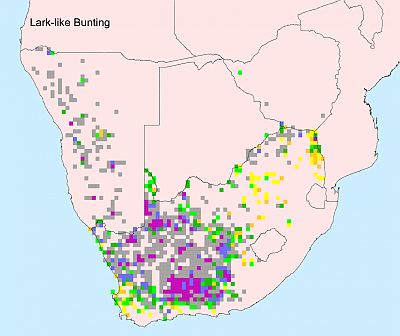
Habitat
Karoo scrub, dry rocky valleys and open plains, thornveld and dry broad-leaved woodland. Gathers in large numbers at waterholes.
Diet
It mainly eats grass seeds, also some insects; foraging on bare ground with scattered shrubs and stones.
Breeding
Monogamous solitary nester, building an untidy cup of coarse twigs lined with fine rootlets and the awns of desert grasses, such as Bushman grass (Stipagrostis ciliata). It is typically placed on a rocky ridge or on stony ground, often at the base of a small rock or beneath a shrub. Egg-laying season varies according to rainfall, but it is generally from September-April. It lays 2-4 blue, brown speckled eggs, which are incubated for about 11-13 days. Chicks stay in the nest for about 12-13 days.
Call
A soft, nasal tuc-tuc a short, rapid buzzy song. Listen to Bird Call.
Status
Common resident and nomadic, near-endemic. Usually gregarious; in loose flocks from a few birds to hundreds.
Order: Passeriformes. Family: Emberizidae
Description
Size 14 cm. A dowdy, nondescript bird that looks like a lark but behaves in typical bunting fashion. It lacks any diagnostic field characteristics apart from pale eyebrow, pale cinnamon wash over the breast and rufous edging to the wing feathers.
Adult: Crown and nape buffy brown, finely streaked with olive-brown; cheeks and ear coverts buffy brown. Indistinct supercilium and moustachial stripe pale pinkish buff. Neck, mantle and back as crown, but streaking heavier on mantle, lighter on lower back. Rump buffy brown, upper tail coverts olive-brown. Tail olive-brown, all rectrices finely edged buff. Primaries dark brown, edged cinnamon; secondaries dark brown, edged pinkish cinnamon. Lesser and median coverts pinkish cinnamon, feathers with dark brown centres. Greater coverts cinnamon, with dark brown centres. Axillaries and underwing coverts pinkish buff. Throat pale pinkish buff. Breast dark buff, shading to pinkish buff on belly and undertail coverts. Upper mandible dark horn, lower mandible pale horn. Eyes brown. Legs and feet pinkish brown.
Female and juvenile are paler than male.
It is similar to the larks and is distinguished from this group by its longer tail and short legs.
Distribution
Occurs from southern DRC, Angola and western Zambia south to southern to southern Africa. Here it is especially common in the western of South Africa and Namibia, extending into Botswana, southern Zimbabwe and the Limpopo and North-West Provinces.

Habitat
Karoo scrub, dry rocky valleys and open plains, thornveld and dry broad-leaved woodland. Gathers in large numbers at waterholes.
Diet
It mainly eats grass seeds, also some insects; foraging on bare ground with scattered shrubs and stones.
Breeding
Monogamous solitary nester, building an untidy cup of coarse twigs lined with fine rootlets and the awns of desert grasses, such as Bushman grass (Stipagrostis ciliata). It is typically placed on a rocky ridge or on stony ground, often at the base of a small rock or beneath a shrub. Egg-laying season varies according to rainfall, but it is generally from September-April. It lays 2-4 blue, brown speckled eggs, which are incubated for about 11-13 days. Chicks stay in the nest for about 12-13 days.
Call
A soft, nasal tuc-tuc a short, rapid buzzy song. Listen to Bird Call.
Status
Common resident and nomadic, near-endemic. Usually gregarious; in loose flocks from a few birds to hundreds.
Lark-like Bunting Photos
887. Lark-like Bunting Emberiza impetuani (Vaalstreeploppie)
 © Toko
© Toko
Mapungubwe National Park, Limpopo
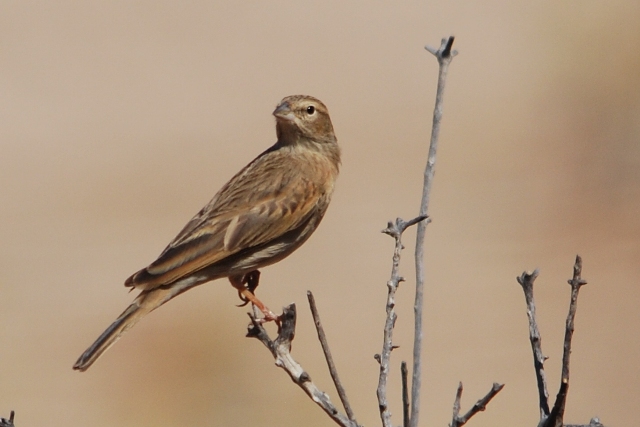 © Mel
© Mel
Kgalagadi Transfrontier Park
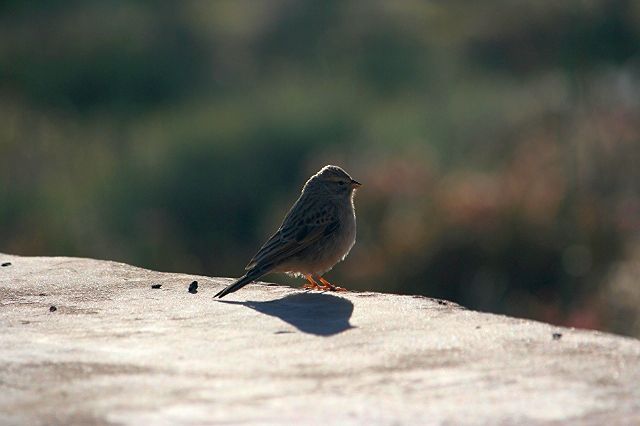 © Tina
© Tina
Tankwa Karoo National Park, Elandsberg
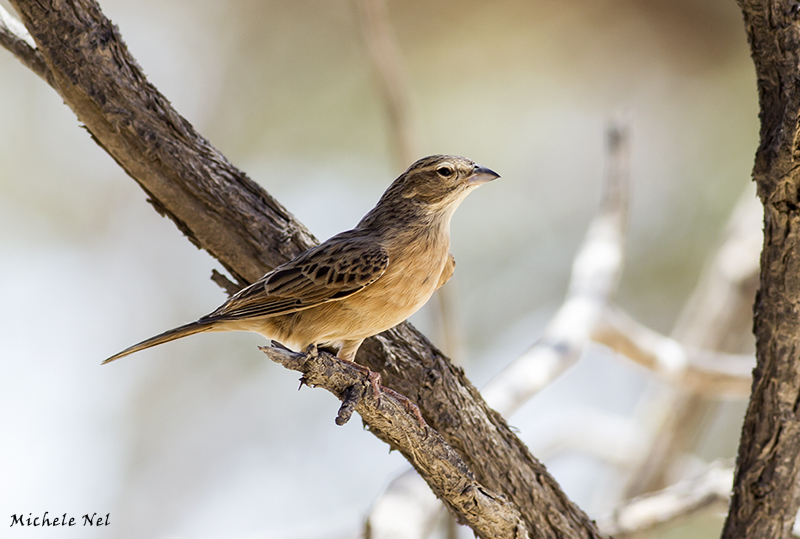 © Michele Nel
© Michele Nel
Nossob, Kgalagadi Transfrontier Park
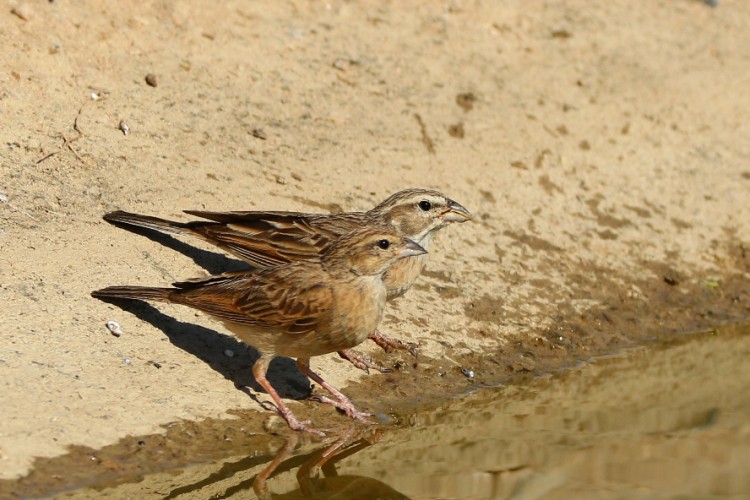 © Dindingwe
© Dindingwe
Brandberg, Namibia
Links:
Species Text Sabap1,
Sabap2
Clive Byers, Urban Olsson, Jon Curson. Buntings and Sparrows
 © Toko
© TokoMapungubwe National Park, Limpopo
 © Mel
© MelKgalagadi Transfrontier Park
 © Tina
© TinaTankwa Karoo National Park, Elandsberg
 © Michele Nel
© Michele NelNossob, Kgalagadi Transfrontier Park
Brandberg, Namibia
Links:
Species Text Sabap1,
Sabap2
Clive Byers, Urban Olsson, Jon Curson. Buntings and Sparrows
Cinnamon-breasted Bunting
886. Cinnamon-breasted Bunting (formerly known as Rock Bunting) Emberiza tahapisi (Klipstreepkoppie)
Order: Passeriformes. Family: Emberizidae
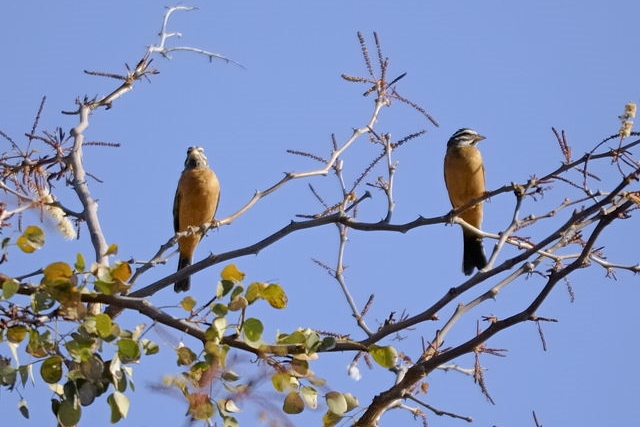
Description
Length 15 cm, mass 15 g.
Adult male: Upperparts are black with brown margins to the feathers. Head boldly striped black and white; mantle to upper tail coverts cinnamon with dark brown markings. Tail and flight feathers dark brown, edged cinnamon. Dark throat with cinnamon washed underparts.
Adult female: Similar to the male, but paler; above less reddish.
Juvenile is similar to female but flecked with brown below.
Similar species: Key features separating it from Cape Bunting are the cinnamon (not grey) underparts, blackish (not white) throat, yellowish-horn coloured (not black) bill and black and white striped head. It also lacks the contrasting chestnut wing coverts. The Cape Bunting differs mainly in having a white throat and grey underparts.
Distribution
Occurs across much of sub-Saharan Africa, from Senegal to Ethiopia through the DRC, Tanzania, Namibia (found in Epupa Falls, Kaokoland and Damaraland, north of Mariental through Windhoek to Otjiwarongo), Zambia, Angola and Malawi to southern Africa. In southern Africa, widespread in the east and north, but absent from most of Namib, Kalahari and Karoo, and coastal regions of KwaZulu-Natal. It is distributed mainly in the eastern half of southern Africa, from the eastern Cape Province northward through Lesotho, KwaZulu-Natal, the Free State (where it avoids the northcentral area), throughout the Transvaal, Swaziland and Zimbabwe, and eastern Botswana. It clearly avoids coastal regions. The distribution seems entirely confined to summer-rainfall areas.

Habitat
Rocky hillsides or boulder strewn habitats, dry watercourses, quarries and mixed woodland.
Diet
Grass seeds, green leaves, nectar and insects. It forages on bare ground among rocks, occasionally plucking food from grass and hawking termite alates aerially.
Breeding
Monogamous solitary nester. The female builds a shallow cup of grass, rootlets and fine twigs on a foundation of large twigs, neatly lined with fine grass and rootlets. It is typically placed in a shallow depression in the ground at the base of a grass tuft or rock, on an earthen bank, in a crevice in a small rock face or among scattered rocks in a hollow. Egg-laying season is from October-June, peaking from January-April. The female lays 2-4 pale greenish eggs with dark brown spots, which are incubated by both sexes for about 12-14 days. The chicks fed by parents in the nest for 13-16 days before fledgeing and the young remain in their natal territory for up to 2 months.
Call
Song is an ascending series of fast Chip-chip-iperezzzzz which sometimes ends with a short buzzing sound. Call a nasal sounding dwe-wer-errr. Flight call a soft twee. Listen to Bird Call.
Status
Common, with both resident and breeding migrant populations.
Order: Passeriformes. Family: Emberizidae

Description
Length 15 cm, mass 15 g.
Adult male: Upperparts are black with brown margins to the feathers. Head boldly striped black and white; mantle to upper tail coverts cinnamon with dark brown markings. Tail and flight feathers dark brown, edged cinnamon. Dark throat with cinnamon washed underparts.
Adult female: Similar to the male, but paler; above less reddish.
Juvenile is similar to female but flecked with brown below.
Similar species: Key features separating it from Cape Bunting are the cinnamon (not grey) underparts, blackish (not white) throat, yellowish-horn coloured (not black) bill and black and white striped head. It also lacks the contrasting chestnut wing coverts. The Cape Bunting differs mainly in having a white throat and grey underparts.
Distribution
Occurs across much of sub-Saharan Africa, from Senegal to Ethiopia through the DRC, Tanzania, Namibia (found in Epupa Falls, Kaokoland and Damaraland, north of Mariental through Windhoek to Otjiwarongo), Zambia, Angola and Malawi to southern Africa. In southern Africa, widespread in the east and north, but absent from most of Namib, Kalahari and Karoo, and coastal regions of KwaZulu-Natal. It is distributed mainly in the eastern half of southern Africa, from the eastern Cape Province northward through Lesotho, KwaZulu-Natal, the Free State (where it avoids the northcentral area), throughout the Transvaal, Swaziland and Zimbabwe, and eastern Botswana. It clearly avoids coastal regions. The distribution seems entirely confined to summer-rainfall areas.

Habitat
Rocky hillsides or boulder strewn habitats, dry watercourses, quarries and mixed woodland.
Diet
Grass seeds, green leaves, nectar and insects. It forages on bare ground among rocks, occasionally plucking food from grass and hawking termite alates aerially.
Breeding
Monogamous solitary nester. The female builds a shallow cup of grass, rootlets and fine twigs on a foundation of large twigs, neatly lined with fine grass and rootlets. It is typically placed in a shallow depression in the ground at the base of a grass tuft or rock, on an earthen bank, in a crevice in a small rock face or among scattered rocks in a hollow. Egg-laying season is from October-June, peaking from January-April. The female lays 2-4 pale greenish eggs with dark brown spots, which are incubated by both sexes for about 12-14 days. The chicks fed by parents in the nest for 13-16 days before fledgeing and the young remain in their natal territory for up to 2 months.
Call
Song is an ascending series of fast Chip-chip-iperezzzzz which sometimes ends with a short buzzing sound. Call a nasal sounding dwe-wer-errr. Flight call a soft twee. Listen to Bird Call.
Status
Common, with both resident and breeding migrant populations.
Dewi
What is the good of having a nice house without a decent planet to put it on? (H D Thoreau)
What is the good of having a nice house without a decent planet to put it on? (H D Thoreau)
Cinnamon-breasted Bunting Photos
886. Cinnamon-breasted Bunting Emberiza tahapisi (Klipstreepkoppie)
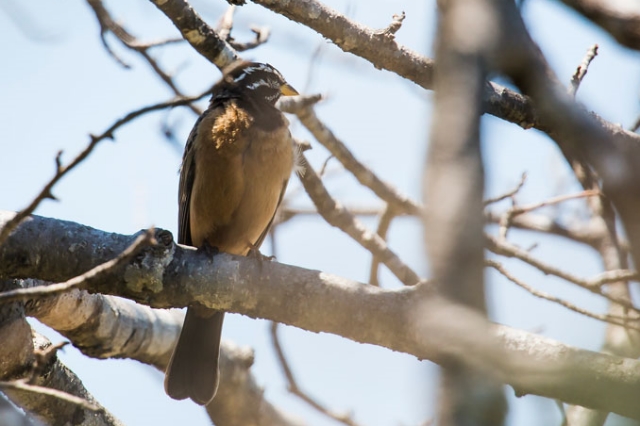 © Pumbaa
© Pumbaa
Kruger National Park
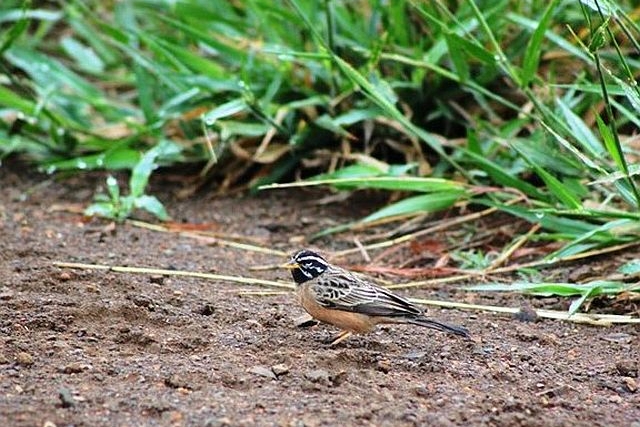 © Heksie
© Heksie
Kruger National Park, S29
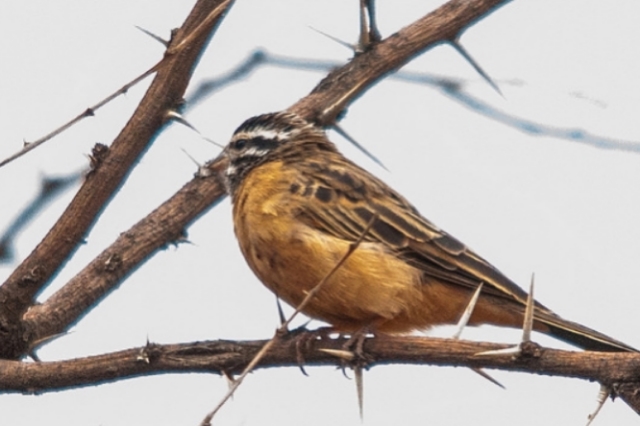 © steamtrainfan
© steamtrainfan
Pilanesberg
Links:
http://sabap2.adu.org.za/docs/sabap1/886.pdf
http://sabap2.adu.org.za/species_info.p ... #menu_left
 © Pumbaa
© PumbaaKruger National Park
 © Heksie
© HeksieKruger National Park, S29
 © steamtrainfan
© steamtrainfanPilanesberg
Links:
http://sabap2.adu.org.za/docs/sabap1/886.pdf
http://sabap2.adu.org.za/species_info.p ... #menu_left
Dewi
What is the good of having a nice house without a decent planet to put it on? (H D Thoreau)
What is the good of having a nice house without a decent planet to put it on? (H D Thoreau)
Cape Bunting
885. Cape Bunting Emberiza capensis (Rooivlerkstreepkoppie)
Order: Passeriformes. Family: Emberizidae
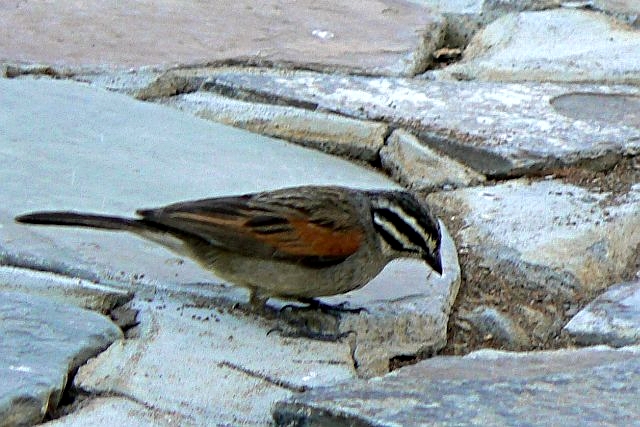 © Toko
© Toko
Male, Tankwa Karoo National Park
Description
The Cape Bunting is 16 cm long.
Adult male: Forehead, crown and nape smoky grey, heavily streaked blackish brown. Off-white supercilium from bill to nape. Blackish-brown line through eyes; off-white stripe below eyes, and another blackish-brown stripe below that, all extending from bill to nape or base of neck. Neck, mantle and back pinkish brown, heavily marked blackish brown.
The sexes are very similar, but females may have a buff tone to the white head markings.
Young birds have duller chestnut wings, a less distinct head pattern, and heavier streaking extending on to the breast and flanks.
Similar species: The greyish breast, chestnut wing coverts, and lack of black on the throat differentiate this species from Cinnamon-breasted Bunting.
Distribution
It occurs from Angola and Malawi to southern Africa, where it is especially common in South Africa and Lesotho while more scarce in patches of Namibia and Zimbabwe, marginally extending into Botswana and Mozambique.
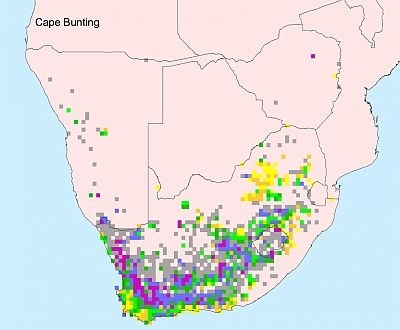
Habitat
It prefers arid scrubland, open woodland along dry watercourses and rocky hillsides, and may also be found in quieter gardens where it becomes quite accustomed to the presence of humans.
Diet
It mainly eats seeds, fruit, basal nodes of grasses and arthropods, doing most of its foraging on the ground among rocks, forbs and shrubs, sometimes entering buildings to feed on food items on the floor.
Breeding
Monogamous solitary nester, building a cup of grass, roots and twigs lined with rootlets, fine grass, fluffy seeds and hair. It is typically placed in a low shrub, bush or creeper, but it may also use overgrown rock ledges and man-made sites. Egg-laying season is from October-June, peaking from September-November in South Africa and from December-April in Zimbabwe. The female lays a clutch of two to five white or pale bluish-green eggs that hatch after an incubation period of 13-16 days. The chicks are fed by both parents, leaving the nest after about 10-13 days.
Call
The call is an ascending zzoo-zeh-zee-zee. The song is a loud chirping chup chup chup chup chee chhep chu. Listen to Bird Call.
Status
Locally common near-endemic.
Order: Passeriformes. Family: Emberizidae
 © Toko
© TokoMale, Tankwa Karoo National Park
Description
The Cape Bunting is 16 cm long.
Adult male: Forehead, crown and nape smoky grey, heavily streaked blackish brown. Off-white supercilium from bill to nape. Blackish-brown line through eyes; off-white stripe below eyes, and another blackish-brown stripe below that, all extending from bill to nape or base of neck. Neck, mantle and back pinkish brown, heavily marked blackish brown.
The sexes are very similar, but females may have a buff tone to the white head markings.
Young birds have duller chestnut wings, a less distinct head pattern, and heavier streaking extending on to the breast and flanks.
Similar species: The greyish breast, chestnut wing coverts, and lack of black on the throat differentiate this species from Cinnamon-breasted Bunting.
Distribution
It occurs from Angola and Malawi to southern Africa, where it is especially common in South Africa and Lesotho while more scarce in patches of Namibia and Zimbabwe, marginally extending into Botswana and Mozambique.

Habitat
It prefers arid scrubland, open woodland along dry watercourses and rocky hillsides, and may also be found in quieter gardens where it becomes quite accustomed to the presence of humans.
Diet
It mainly eats seeds, fruit, basal nodes of grasses and arthropods, doing most of its foraging on the ground among rocks, forbs and shrubs, sometimes entering buildings to feed on food items on the floor.
Breeding
Monogamous solitary nester, building a cup of grass, roots and twigs lined with rootlets, fine grass, fluffy seeds and hair. It is typically placed in a low shrub, bush or creeper, but it may also use overgrown rock ledges and man-made sites. Egg-laying season is from October-June, peaking from September-November in South Africa and from December-April in Zimbabwe. The female lays a clutch of two to five white or pale bluish-green eggs that hatch after an incubation period of 13-16 days. The chicks are fed by both parents, leaving the nest after about 10-13 days.
Call
The call is an ascending zzoo-zeh-zee-zee. The song is a loud chirping chup chup chup chup chee chhep chu. Listen to Bird Call.
Status
Locally common near-endemic.
Cape Bunting
885. Cape Bunting Emberiza capensis
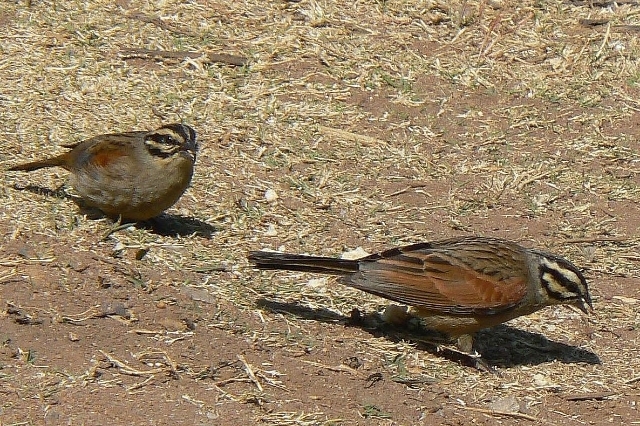
Marakele National Park, Lenong Mountain top
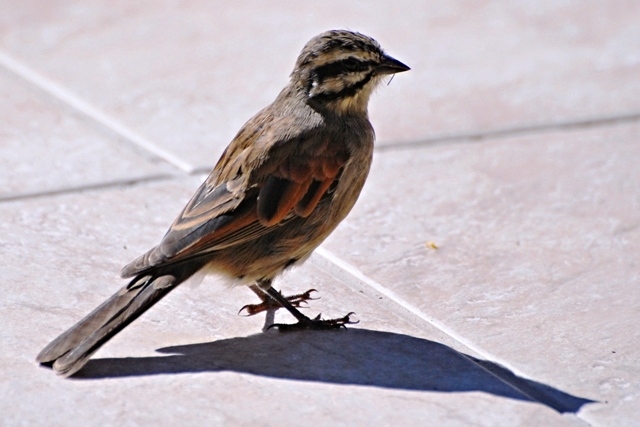 © Mel
© Mel
Female
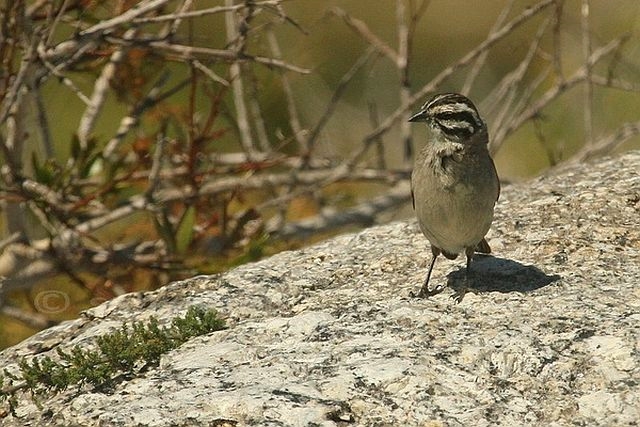 © nan
© nan
Lamberts Bay
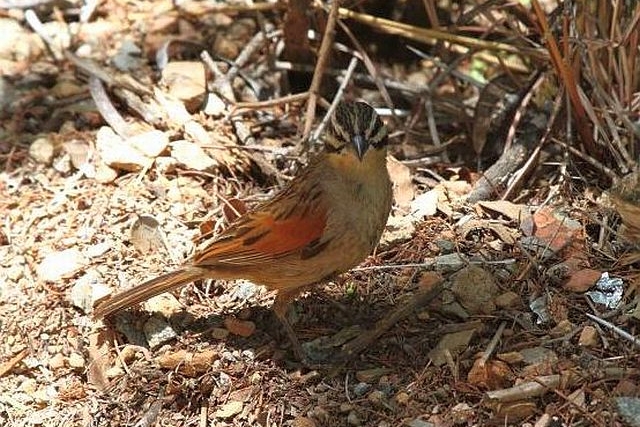 © Sharifa
© Sharifa
Mountain Zebra National Park
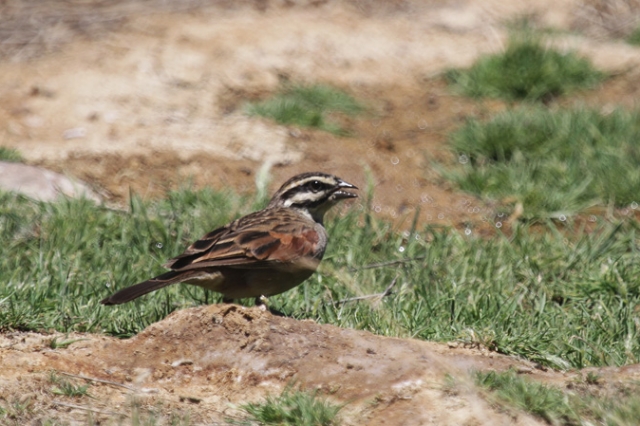 © leachy
© leachy
Tankwa Karoo National Park
Links:
Species text Sabap1
Sabap2

Marakele National Park, Lenong Mountain top
 © Mel
© MelFemale
 © nan
© nanLamberts Bay
 © Sharifa
© Sharifa Mountain Zebra National Park
 © leachy
© leachyTankwa Karoo National Park
Links:
Species text Sabap1
Sabap2
- Flutterby
- Posts: 44150
- Joined: Sat May 19, 2012 12:28 pm
- Country: South Africa
- Location: Gauteng, South Africa
- Contact:
Golden-breasted Bunting
884. Golden-breasted Bunting Emberiza flaviventris (Rooirugstreepkoppie)
Order: Passeriformes. Family: Emberizidae
Description
15-16 cm. Has a white crown with black lateral crown stripes and white supercilium, black-bordered white ear coverts. Chestnut mantle and a rich yellow breast washed with orange. The white wing bars are conspicuous in flight. Whitish lower belly, grey rump.
Sexes are very similar, but females have buff tone to head, browner head stripes, and the back may have dark streaks.
Juveniles are duller and paler than the females.
Similar species: Altough very similar to Cabanis's Bunting (in Zimbabwe), this species differs in having a white stripe below the eye, a chestnut (not greyish) mantle, and a richer yellow breast, washed with orange.
Distribution
Occurs in Sub-Saharan Africa from southern Mali to Sudan south through Uganda, Tanzania, southern DRC, Angola and Zambia to southern Africa. Here it is fairly common across Mozambique, Zimbabwe, Botswana, northern Namibia and much of South Africa largely excluding the Western Cape, Northern Cape and the Free State.

Habitat
Thornveld, broadleafed woodland and exotic plantations.
Diet
A ground feeder, the diet includes seeds, insects and spiders and sometimes larger creatures when the birds have young to feed.
Breeding
Monogamous solitary nester, building an untidy cup of grass stems, tendrils, leaf petioles and other pliable plant material, lined with fine rootlets and hair. It is typically placed on a horizontal fork of a bush or tree, such as an Acacia or fingerleaf (Vitex). Egg-laying season is from September-April, peaking from October-December. The 2-3 glossy, black-lined, white or cream eggs are incubated for 12-13 days solely by the female. The chicks are fed by both parents on a diet of insects and seeds; the young fledge in another 16-17 days.
Call
The Golden-breasted Bunting’s call is a nasal ascending zzhrr. The song is variable, but includes a weechee weechee weechee. Listen to Bird Call.
Status
A common resident.
Order: Passeriformes. Family: Emberizidae
Description
15-16 cm. Has a white crown with black lateral crown stripes and white supercilium, black-bordered white ear coverts. Chestnut mantle and a rich yellow breast washed with orange. The white wing bars are conspicuous in flight. Whitish lower belly, grey rump.
Sexes are very similar, but females have buff tone to head, browner head stripes, and the back may have dark streaks.
Juveniles are duller and paler than the females.
Similar species: Altough very similar to Cabanis's Bunting (in Zimbabwe), this species differs in having a white stripe below the eye, a chestnut (not greyish) mantle, and a richer yellow breast, washed with orange.
Distribution
Occurs in Sub-Saharan Africa from southern Mali to Sudan south through Uganda, Tanzania, southern DRC, Angola and Zambia to southern Africa. Here it is fairly common across Mozambique, Zimbabwe, Botswana, northern Namibia and much of South Africa largely excluding the Western Cape, Northern Cape and the Free State.

Habitat
Thornveld, broadleafed woodland and exotic plantations.
Diet
A ground feeder, the diet includes seeds, insects and spiders and sometimes larger creatures when the birds have young to feed.
Breeding
Monogamous solitary nester, building an untidy cup of grass stems, tendrils, leaf petioles and other pliable plant material, lined with fine rootlets and hair. It is typically placed on a horizontal fork of a bush or tree, such as an Acacia or fingerleaf (Vitex). Egg-laying season is from September-April, peaking from October-December. The 2-3 glossy, black-lined, white or cream eggs are incubated for 12-13 days solely by the female. The chicks are fed by both parents on a diet of insects and seeds; the young fledge in another 16-17 days.
Call
The Golden-breasted Bunting’s call is a nasal ascending zzhrr. The song is variable, but includes a weechee weechee weechee. Listen to Bird Call.
Status
A common resident.
- Flutterby
- Posts: 44150
- Joined: Sat May 19, 2012 12:28 pm
- Country: South Africa
- Location: Gauteng, South Africa
- Contact:
Golden-breasted Bunting Photos
Golden-breasted Bunting Emberiza flaviventris
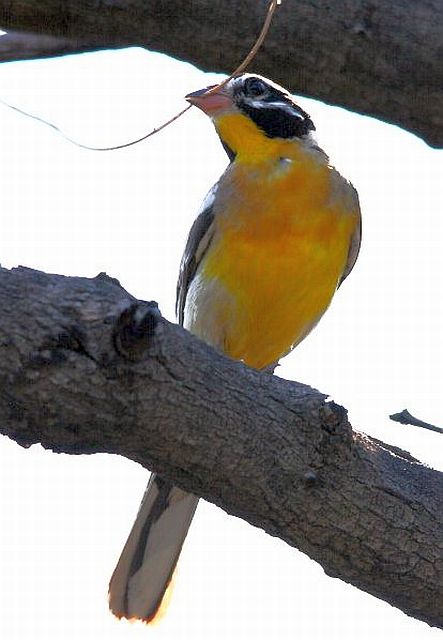 © Flutterby
© Flutterby
Pilanesberg
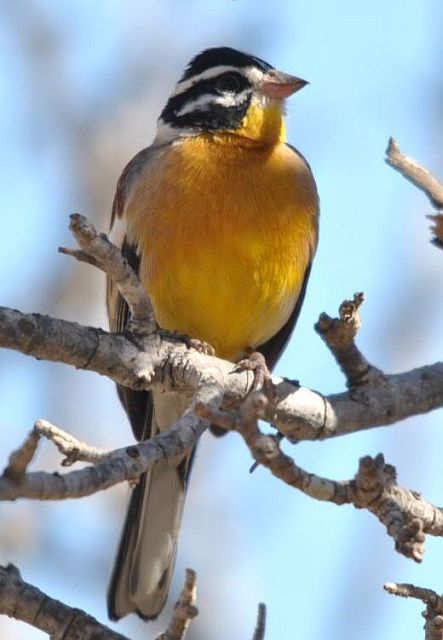 © lowveldboy
© lowveldboy
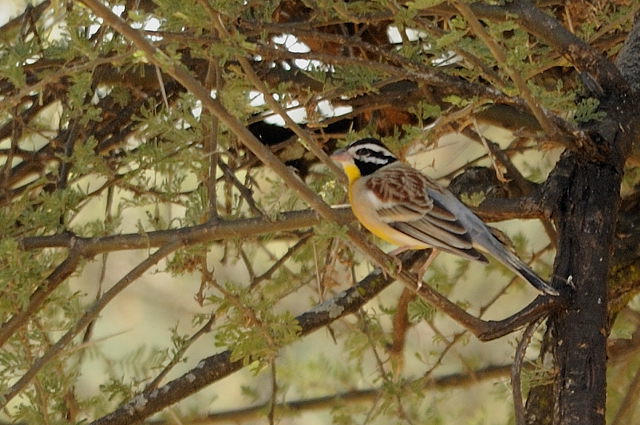 © Dewi
© Dewi
Kruger
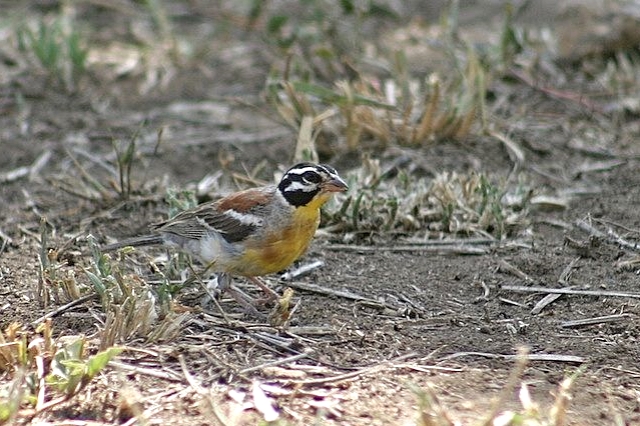 © ExFmem
© ExFmem
Kruger National Park, Satara
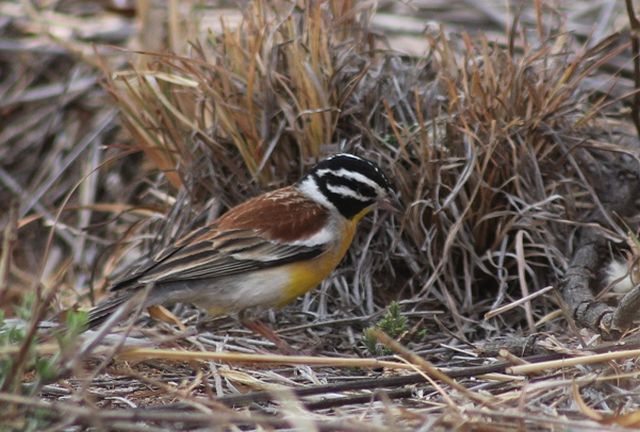 © Amoli
© Amoli
Pilanesberg
Links:
Sabap2
 © Flutterby
© FlutterbyPilanesberg
 © lowveldboy
© lowveldboy © Dewi
© DewiKruger
 © ExFmem
© ExFmemKruger National Park, Satara
 © Amoli
© AmoliPilanesberg
Links:
Sabap2


